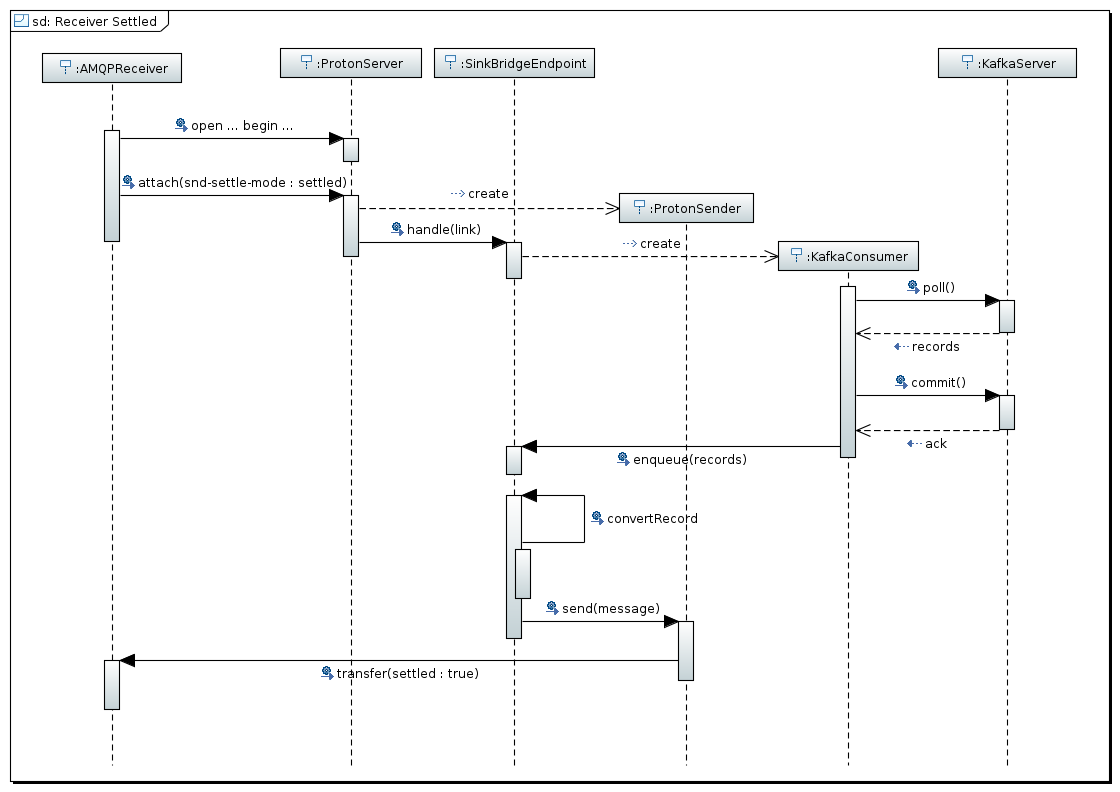-
Notifications
You must be signed in to change notification settings - Fork 119
Receiver
Following the Sequence Diagrams for the receiving operation by AMQP receiver clients.
In this scenario the AMQP receiver requests for the snd-settle-mode as settled on link attachment so it expects to receive messages with the settled flag to true from the internal AMQP sender. The sink bridge endpoint gets messages from the Kafka server using the internal Kafka Consumer and uses the internal AMQP sender to send them to the receiver. The operations sequence is the following :
- the Kafka Consumer poll for records from Kafka server
- the Kafka Consumer executes immediately a commit on Kafka server in order to save the offset of records read
- the above records are copied into an internal queue which is read by the AMQP sender in order to send messages
In tha above sequence, if Kafka Consumer commit fails, messages aren't sent but on next poll they will be retrivied another time. Otherwise, if the sending operation fails and some messages aren't sent, they will be lost because Kafka Consumer has already committed the offset. On the internal AMQP sender side, it sends messages and doesn't wait for any acknowledgment from receiver. We can consider it an AT MOST ONCE delivery.

In this scenario the AMQP receiver requests for the snd-settle-mode as unsettled on link attachment so it expects to receive messages with the settled flag to false from the internal AMQP sender in order to reply with a disposition message contains settled flat to true. The sink bridge endpoint gets messages from the Kafka server using the internal Kafka Consumer and uses the internal AMQP sender to send them to the receiver. The operations sequence is the following :
- the Kafka Consumer poll for records from Kafka server
- the above records are copied into an internal queue which is read by the AMQP sender in order to send messages
- the Kafka Consumer checks if it's needed to commit on Kafka server in order to save the offset of messages polled, sent and acknowledged by receiver
In tha above sequence, if Kafka Consumer commit fails, messages already sent by the internal AMQP sender will be polled next time and re-sent. The commit depends on feedback that the internal AMQP sender is receiving from receiver (disposition frame). An OffsetTracker is used in order to track what is offsets related to acked messages and that the Kafka Consumer has to commit.
If receiver ack the message in order, all works fine. If receiver ack the message OUT OF ORDER we could have messages loss and it depends on the following available solutions :
-
Tracking ONLY the offset for the LAST settled (acked) message. If there are unsettled message before it they won't be redelivered. It means AT LEAST ONCE NOT guaranteed.
-
Tracking the offset related to the settled (acked) message JUST BEFORE the first NOT settled yet. After that other messages could be acked. When the first unsettled message will be acked, the tracker jumps forward to the last offset JUST BEFORE the first NOT settled message : it will be the offset committed by the Kafka Consumer. In this solution it's possible that messages already settled after the first NOT settled yet will be redelivered. It means AT LEAST ONCE.

In this scenario the AMQP receiver specifies the snd-settle-mode as mixed so it can mix the above behavior for each single message.
The flow control related to the messages from Apache Kafka to AMQP receivers is handled in two ways :
- the sink endpoint takes in account the credits granted by the AMQP reicever. If credits end, the sink endpoint pauses the Kafka consumer to avoid reading other messages from the server. When the AMQP receiver grants new credits to the sink endpoint then it resumes Kakfa consumer;
- in order to avoid a lot of memory allocation for internal buffering from Kafka consumer to the internal AMQP sender (in the sink endpoint), a threadshold for that buffer is defined. When the buffer effective size exceeds this threashold, the sink endpoint pauses Kafka consumer and resumes it only when more space in the buffer is available;